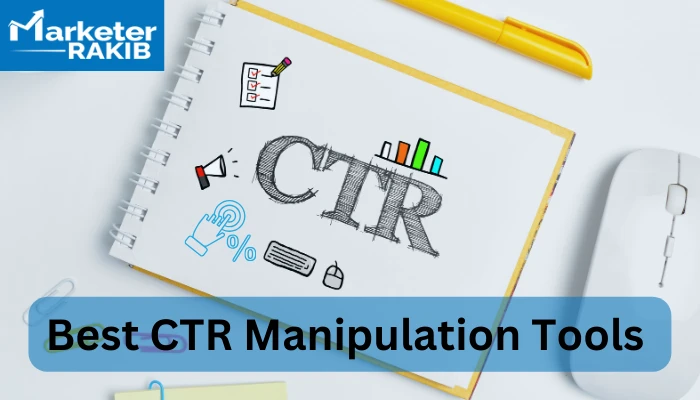Accomplishing Success With Targeted CTR Adjustment
The optimization of click-through prices (CTR) is an essential undertaking for brand names aiming to improve their electronic existence and maximize engagement. Targeted CTR manipulation incorporates a variety of strategies, from data-driven advertisement placements to the growth of compelling web content customized to certain audiences. Recognizing the subtleties of individual habits and utilizing strategies such as A/B screening can dramatically influence efficiency end results. The trip to grasping these techniques is complicated and needs a continuous dedication to evaluation and improvement. The concern continues to be: what details strategies will produce the most substantial results in this dynamic landscape?
Comprehending Click-Through Fees
Click-through rates (CTR) function as an essential statistics in electronic marketing, showing the efficiency of on-line content in driving individual interaction. This metric is determined by dividing the number of clicks an ad or web link obtains by the total number of impressions, revealed as a portion (CTR Manipulation Service). A greater CTR shows that the material reverberates well with the target market, triggering them to do something about it
Recognizing CTR is necessary for marketing experts intending to maximize their projects. Various variables affect CTR, including ad positioning, style, and the importance of the web content to the audience's passions. As an example, engaging headlines and aesthetically enticing pictures can considerably boost the chance of users clicking on a link.
Additionally, the context in which the web content is presented plays a vital function in establishing CTR. Ads presented at strategic times or throughout pertinent events are more probable to catch attention. By analyzing CTR information, marketers can identify fads and areas for enhancement, enabling more targeted methods. Ultimately, a thorough understanding of CTR equips marketing experts to refine their strategies, ensuring that digital projects achieve their wanted results efficiently.
Significance of CTR Manipulation
In the competitive landscape of electronic marketing, the adjustment of click-through rates (CTR) has come to be a crucial method for boosting project efficiency. CTR acts as an essential performance sign, reflecting the effectiveness of online advertisements and content in attracting user involvement. A greater CTR not only represents better rate of interest however additionally can lead to improved online search engine positions and lower cost-per-click (CPC) rates, therefore optimizing total advertising and marketing spending plans.
The significance of CTR control hinges on its capability to inform marketing experts regarding customer choices and habits. By assessing CTR information, businesses can determine which components of their campaigns resonate most with their target market. This insight permits more enlightened decision-making and the allotment of sources to the most efficient networks.
Furthermore, efficient CTR control promotes an affordable advantage. Thus, grasping CTR control is not merely helpful; it is important for achieving continual success in electronic advertising and marketing efforts.
Strategies for Targeted CTR
Accomplishing targeted click-through rates (CTR) needs a calculated approach that includes various techniques customized to particular target market segments. One efficient strategy is enhancing ad placements by imp source using information analytics to determine high-performing channels. By focusing initiatives on these channels, marketers can improve exposure and boost involvement.
An additional critical approach is crafting compelling headlines and calls to activity (CTAs) A/B screening different variations can reveal which combinations resonate most with the target market, consequently driving higher CTR. In addition, incorporating visual components such as attractive images or videos can dramatically enhance charm, making material much more interesting and shareable.
Personalization likewise plays a vital function; making use of user data to create tailored material can cultivate a feeling of importance, encouraging clicks. Leveraging social evidence through reviews and user-generated web content can construct count on, ultimately boosting CTR.
Analyzing User Actions
 Recognizing user behavior is necessary for optimizing advertising techniques and boosting total performance. By examining exactly how users interact with web content, marketers can obtain beneficial insights right into preferences, inspirations, and discomfort points. This knowledge enables the advancement of more targeted projects that resonate with specific target market segments.
Recognizing user behavior is necessary for optimizing advertising techniques and boosting total performance. By examining exactly how users interact with web content, marketers can obtain beneficial insights right into preferences, inspirations, and discomfort points. This knowledge enables the advancement of more targeted projects that resonate with specific target market segments.To efficiently analyze customer behavior, numerous tools and techniques can be employed. Internet analytics systems supply information on individual engagement metrics such as click-through prices, bounce rates, and time invested in web page. Heatmaps and session recordings allow online marketers to visualize individual communications, revealing which elements stand out and which might be overlooked.
Furthermore, user feedback with studies and responses forms can use qualitative understandings, enhancing the understanding of user view and fulfillment. Segmenting customers based upon demographics, check over here habits, and passions can additionally improve targeting initiatives, customizing content to fulfill diverse demands.
Inevitably, continual evaluation of individual habits is crucial for adjusting advertising strategies in real-time. As customer fads evolve, remaining attuned to these adjustments ensures that campaigns remain reliable and pertinent, promoting a much deeper link with the target audience. This fundamental understanding establishes the phase for the successful application of targeted CTR control strategies.
Gauging Success and Changing Techniques
Measuring success in targeted advertising campaigns calls for a critical technique that integrates efficiency metrics with recurring analysis. Secret efficiency signs (KPIs) such as click-through prices (CTR), conversion rates, and consumer purchase expenses should be monitored continually to gauge the performance of control strategies. By developing a standard, marketing professionals can analyze modifications in CTR and identify fads that suggest effective interaction or possible imperfections.
Frequently assessing these metrics enables the prompt modification of techniques. As an example, if a certain project shows a substantial decline in CTR, it might signify the demand for innovative revisions or a reevaluation of targeting specifications. Employing A/B testing can even more refine strategies by comparing variants of ads or landing web pages, offering understanding right into what resonates ideal with the target market.
Furthermore, incorporating qualitative comments through studies or user meetings can supplement quantitative information, providing a comprehensive sight of target market understanding. Ultimately, the capacity to iteratively assess and improve strategies based upon real-time data promotes a much more receptive marketing strategy, ensuring that projects stay aligned with service purposes and target market choices. This flexible technique is essential in achieving continual success in targeted CTR control.
Conclusion
In verdict, targeted CTR control is crucial for maximizing digital advertising initiatives. By understanding click-through prices and using strategic techniques, brands can properly enhance customer involvement and drive conversions. Continuous evaluation of customer behavior and thorough measurement of performance indications promote timely changes, making sure positioning with consumer choices. Inevitably, successful CTR control not only raises visibility but additionally fosters trust and reputation, thereby contributing to continual development in open markets.
 Targeted CTR manipulation includes an array of methods, from data-driven ad placements to the advancement of compelling content customized to certain audiences.Click-through prices (CTR) serve as a critical statistics Home Page in digital advertising and marketing, mirroring the efficiency of on-line material in driving user involvement. A higher CTR shows that the content resonates well with the target audience, prompting them to take activity.
Targeted CTR manipulation includes an array of methods, from data-driven ad placements to the advancement of compelling content customized to certain audiences.Click-through prices (CTR) serve as a critical statistics Home Page in digital advertising and marketing, mirroring the efficiency of on-line material in driving user involvement. A higher CTR shows that the content resonates well with the target audience, prompting them to take activity.CTR serves as a key efficiency indicator, showing the efficiency of on the internet advertisements and content in drawing in user involvement.In conclusion, targeted CTR adjustment is vital for enhancing digital advertising efforts.